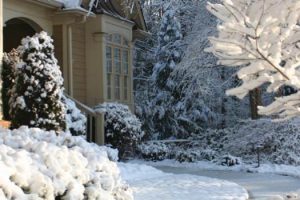
Fertilize For Future Growth
Grass leaves grow much more slowly as the weather turns cool, but the grass roots and rhizomes continue to grow quickly. Your lawn may not use the fertilizer in its dormant stage but it will draw upon the nutrients as soon as the weather starts to warm up.
Cut Grass Short
As the season draws to a close, drop the mower’s blade to its lowest setting for the last two cuttings of the year. That will allow more sunlight to reach the crown of the grass, and there will be less leaf to turn brown during the winter.
Rake Leaves
I know raking leaves is no one’s idea of fun, but it’s important to remove fallen leaves from your lawn as soon as possible. Leaves may smother yur lawn and stunt the growth of new grass.
Prune Plants
Pruning in late winter leaves fresh wounds exposed for only a short amount of time before new growth begins. The late dormant season is best for pruning.
Prepare for Ice and Snow
While it’s true that heavy, wet snows and ice often cause broken branches, snow itself will not hurt landscape plants. In fact, the opposite is true. Snow is a very good insulator against chilling temperatures that may injure plants. Remove limbs that may break from snow or ice as damaged trees are more prone to disease.
Protect Against Water Loss
Water is a crucial prerequisite for plant life. Both the shortage and the excess of water may cause severe stress to plants. A substance such as pine oil can be is usually sprayed on plant surfaces such as the leaves and stems to reduce transpiration and inhibit water loss —called also antidesiccant.. Sometime to protect against salt spray and winter winds burlap wrapping on valuable evergreens may be used.
Why Mulch in the Winter?
The main idea behind winter mulching is to keep the ground frozen by shielding it from the warmth of the sun. A steady temperature will keep the plant in dormancy and prevent it from triggering new growth during a brief warm spell. Tender, new growth too soon will just result in more winter die back. Mulching will also help conserve whatever water is in the soil.
Apply Wire Mesh to the Base of Trees
Beavers, rabbits and rodents feed on tree bark and young trunks. Most wildlife feeding damage occurs when natural food is scarce or unavailable from winter to early spring. You can make wire mesh cylinders to protect your tree trunks from wildlife damage.
Or… just leave it up to A&A Lawn Care & Landscaping to do all of this for you so you don’t have to worry about it! We help our residential and commercial clients with their lawns and landscaping all year ’round!
Contact Us (859-384-0266) for a Free Consultation!
—
 About A & A Lawn Care & Landscaping
About A & A Lawn Care & Landscaping
A & A Lawn Care & Landscaping can beautify your lawn and landscaping using our vast experience in turf grass management. Our complete lawn service is designed for both residential and commercial lawns and we keep your lawn healthy without harming your family, staff, or pets.

 About A & A Lawn Care & Landscaping
About A & A Lawn Care & Landscaping